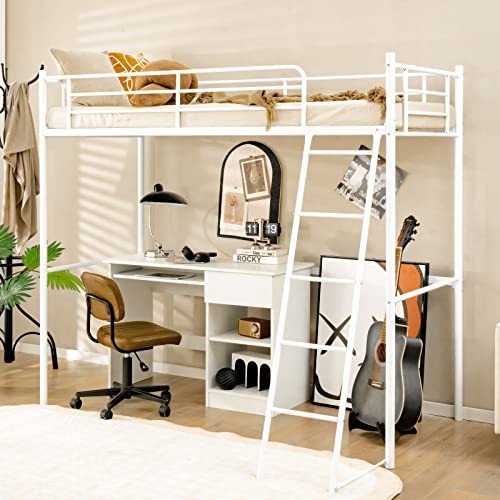
Bunk Beds Uk
Add a review FollowOverview
-
Founded Date March 28, 1991
-
Sectors Sales & Marketing
-
Posted Jobs 0
-
Viewed 13
Company Description
9 Lessons Your Parents Taught You About Bunk Bed For Kids
The Ultimate Guide to Bunk Beds for Kids: Safety, Styles, and Solutions
Bunk beds have long been a popular choice among moms and dads seeking to enhance space in their children’s bed rooms. With benefits that surpass their compact style, bunk beds provide a fun and practical sleeping plan while encouraging sibling bonding and fostering imagination. In this extensive guide, we explore various aspects of bunk beds for kids, consisting of security factors to consider, various styles readily available, and suggestions for picking the best one for your household.
Why Choose Bunk Beds?
Bunk beds are created to stack one bed on top of another, making use of vertical space to produce more space for play and storage. They are particularly advantageous for households with numerous children or minimal bedroom space. In addition, they supply an adventurous sleeping environment that children typically enjoy.
Secret Advantages of Bunk Beds:
- Space-saving style: Ideal for small rooms or shared spaces.
- Economical: Often more budget friendly than purchasing 2 different beds.
- Motivates social interaction: Promotes bonding among siblings or pals.
- Versatile alternatives: Available in numerous designs and configurations to fit any room design.
Safety First: Essential Considerations
When selecting a bunk bed for kids, safety should be the top concern. The following functions are important for guaranteeing a protected sleeping environment:
Important Safety Features:
- Sturdy Construction: Ensure that the bed frame is made from durable materials such as solid wood or metal.
- Guardrails: Bunk beds must have guardrails on both sides of the upper bunk to prevent falls.
- Ladder Safety: A tough, built-in ladder or stairs with anti-slip rungs is important for safe access to the leading bunk.
- Weight Limit: Check the manufacturer’s weight limit capacity for both the top and bottom bunk.
- Mattress Size: Use the proper mattress size as specified by the bed maker to guarantee a tight fit within the bed frame.
Security Tips for Parents:
- Monitor Sleep Habits: Teach children the value of not playing on or leaping off the bunk beds.
- Age Appropriateness: Generally, the upper bunk is appropriate for children aged 6 and older.
- Regular Inspections: Periodically look for any loose bolts, screws, or structural damage.
Styles of Bunk Beds
Bunk beds come in a variety of styles, allowing moms and dads to select one that matches their kid’s room decor while meeting specific requirements. Below are some popular styles:
Popular Bunk Bed Styles:
- Traditional Bunk Beds: Simple and classic styles made from wood or metal with no additional functions.
- Loft Beds: Features a raised top bunk with space below for a desk, play location, or extra storage.
- L-Shaped Bunk Beds: Arranged in an L-shape, frequently ideal for corner spaces and can have additional storage alternatives.
- Twin over Full Bunk Beds: A twin bed on the top and a bigger full-sized bed on the bottom, accommodating children or teens of various ages.
- Triple Bunk Beds: Designed to fit three beds in a single footprint, suitable for larger families or sleepovers.
A Comparison of Bunk Bed Styles
| Bunk Bed Style | Description | Best For |
|---|---|---|
| Conventional | Traditional design with 2 stacked beds | Standard bedroom setups |
| Loft Bed | Raised bed with usable space below | Research or play areas |
| L-Shaped | Bunk beds organized in an L-shape | Corner areas |
| Twin over Full | Twin bed on top, full bed listed below | Various age siblings |
| Triple Bunk | Three stacked beds | Large households or sleepovers |
Selecting the Right Bunk Bed
When looking for the best bunk bed, consider the list below elements to ensure you make an informed decision:
Key Factors to Consider:
- Room Size: Measure the room measurements to determine the suitable size and height of the bunk bed.
- Child’s Age: Consider the age of your kid(ren) when selecting a style and security features.
- Functionality: Think about just how much storage or play space you need and whether the bunk bed need to serve additional purposes.
- Budget plan: Set a budget that consists of not only the bunk bed however also the required bed mattress and devices like bedding or security gates.
FAQs About Bunk Beds for Kids
1. What age is proper for a child to sleep in the top bunk?
Usually, children aged 6 and older ought to have the ability to securely sleep in the top bunk, though you ought to constantly consider your child’s maturity level.
2. Are bunk beds safe for young children?
It is not recommended for toddlers or very young kids to oversleep the top bunk due to the risk of falling.
3. How do I maintain the bunk bed?
Check the bed routinely for any indications of wear and tear, tightening screws, and cleaning the bed mattress to ensure extended safety and durability.
4. Can I convert a bunk bed into two separate beds?
Many bunk beds are developed to be convertible, permitting you to separate the beds when required. Examine the maker’s specs before buying.
5. How can I make the most of space in a bunk bed space?
Utilize under-bed drawers, shelves, or lofted styles to produce extra storage options in a space with a bunk bed.
Bunk beds use a delightful blend of fun, performance, and space-saving energy, making them a best option for young households. By considering security functions, different designs, and practical elements such as space size and age suitability, parents can choose the best bunk bed for their kid’s needs. With the right option, bunk beds can change a bedroom into a wonderful space that encourages play, creativity, and bonding among siblings. Constantly keep in mind to prioritize safety and maintenance to take advantage of this special sleeping plan.



